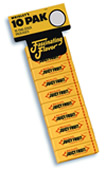
JUICY NEW TECHNOLOGY
The Universal Product Code (UPC) made its first commercial appearance on a 10-Pack of Wrigley's Juicy Fruit gum sold in Marsh's Supermarket in Troy, Ohio on June 26, 1974 for 67 cents. Much has changed.
The ubiquitous bar code is slowly evolving to provide much more than the simple management and tracking of inventory. Today, barcodes track rental cars, air traveler luggage, mail, library books and more. It has processed billions upon billions of items through the checkout counter and sped up the processing of returns.
As bar codes became popular and their convenience universally recognized, the market began to call for codes capable of storing more information.
Efforts to increase the amount of information stored by bar codes, however, caused problems. Enlarging the bar code area complicated reading operations, and increased printing costs.
As a result, a more sophisticated two-dimensional density matrix code (QR CODE), storing information in both vertical and horizontal directions, was developed by Denso Corp. to pack over 300 times the numeric data stored in conventional (UPC) barcodes…. in a minimal amount of space.
QR Codes will go far to break down barriers to mobile e-commerce as scanners are built into state-of-the-art mobile phone and communication devices. Beyond product labeling, these codes can be created to capture data “on the go” on ads, business cards, address books, maps and comparison price shopping. Amazon.com is experimenting with QR codes in Japan, generating affiliate mobile sales through scanner enabled mobile phones.
Applications are as boundless as a marketer’s imagination.


UPC CODE vs. QR CODE








No comments:
Post a Comment